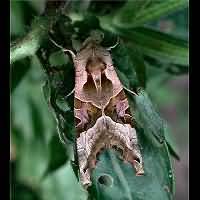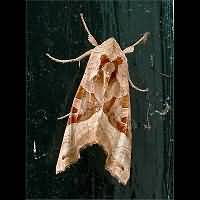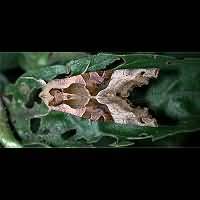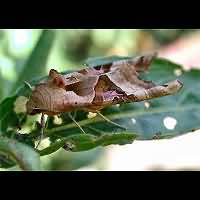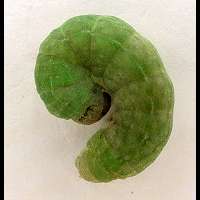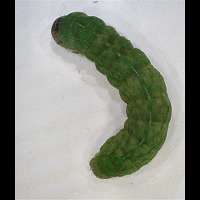Angle Shades Phlogophora meticulosa
The gorgeous Angle Shades looks like a Hawk Moth very much, but it is 'just' an Owlet Moth. The indented wings, the green and pink accents (even though these may be gone in older animals) and the way it often sits quite openly and visibly makes this one of the most seen moths. It is unmistakable. And quite a big species too, for the wingspan varies from 45 to 52mm.
The caterpillar of Angle Shades may be seen all year round. It is active in winter as well, especially on mild days. It is very keen on all kinds of cultivated plants and flowers and is regularly found in gardenplants, even those placed on small balconies. It pupates in a cocoon in the ground. In some gardens and on balconies, when ground is not available, it might pupate in cracks in walls or soft mortar in walls. The caterpillar is extremely variable and might be green, yellow or brown. The head is always green with brownish markings. There is an often vague, light dorsal line and an undefined broad whitish band runs over the spiraculae. The larvae will eat almost anything. Leaves from trees, such as oak, birch and beech, shrubs, such as Bramble and Hazel and many lower plants, such as Common Nettle, Valerian etc, including many cultivars. Very common everywhere, including small and large gardens, parks, balcony plants, garden centers and so on. The caterpillar reaches a length of 38 to 45mm.
Angle Shades is seen from May to October chiefly, but individuals are seen in other months as well, including the winter months, especially during mild winters. Our own animals are joined by migrants from southern parts of Europe. It is believed part of the animals migrate back to Southern Europe in autumn. The moth is attracted by light, sugar and flowers, including garden cultivars. Angle Shades is often seen in daylight resting on posts, fences, walls, tree trunks and vegetation. It only flies by night and is not inclined to be scared when resting. Thus it is easily photographed and may even be handled by the photographer. This makes this one of the best moth mannequins around. In most of Britain and Ireland this is a very common species indeed. In Northern parts of Scotland and the Hebrides it is scarcer though. In other parts of Europe this is a very common species as well, often even abundantly present.
The gorgeous Angle Shades looks like a Hawk Moth very much, but it is 'just' an Owlet Moth. The indented wings, the green and pink accents (even though these may be gone in older animals) and the way it often sits quite openly and visibly makes this one of the most seen moths. It is unmistakable. And quite a big species too, for the wingspan varies from 45 to 52mm.
The caterpillar of Angle Shades may be seen all year round. It is active in winter as well, especially on mild days. It is very keen on all kinds of cultivated plants and flowers and is regularly found in gardenplants, even those placed on small balconies. It pupates in a cocoon in the ground. In some gardens and on balconies, when ground is not available, it might pupate in cracks in walls or soft mortar in walls. The caterpillar is extremely variable and might be green, yellow or brown. The head is always green with brownish markings. There is an often vague, light dorsal line and an undefined broad whitish band runs over the spiraculae. The larvae will eat almost anything. Leaves from trees, such as oak, birch and beech, shrubs, such as Bramble and Hazel and many lower plants, such as Common Nettle, Valerian etc, including many cultivars. Very common everywhere, including small and large gardens, parks, balcony plants, garden centers and so on. The caterpillar reaches a length of 38 to 45mm.
Angle Shades is seen from May to October chiefly, but individuals are seen in other months as well, including the winter months, especially during mild winters. Our own animals are joined by migrants from southern parts of Europe. It is believed part of the animals migrate back to Southern Europe in autumn. The moth is attracted by light, sugar and flowers, including garden cultivars. Angle Shades is often seen in daylight resting on posts, fences, walls, tree trunks and vegetation. It only flies by night and is not inclined to be scared when resting. Thus it is easily photographed and may even be handled by the photographer. This makes this one of the best moth mannequins around. In most of Britain and Ireland this is a very common species indeed. In Northern parts of Scotland and the Hebrides it is scarcer though. In other parts of Europe this is a very common species as well, often even abundantly present.

